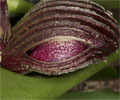|
|
|
|
|
| |
Established Seedlings of
Zootrophion dayanum 'MC4973' × self |
|
| |
|
|
| |
| Number: |
TN7144 |
| Name: |
Zootrophion dayanum 'MC4973' × self
|
| Type: |
self (What's that?) |
|
Click to Enlarge

Pod Parent Flower |
Click to Enlarge

Pod Parent Closeup of Interior |
Click to Enlarge

Pod Parent Capsule at 28 days |
|
|
|
| |
For additional origin/habitat information supplied courtesy of
Charles and Margaret Baker, see further below, near the bottom of this page.
|
Temperatures we attempt to use in the lab & greenhouse:
| For Species: |
|
Spring, Summer, Autumn: days average 73°F, nights 57°F; best fit is Cool-Intermediate 75-58°F
(Source:
Baker's Web OSC) |
| For Species: |
|
Winter: days average 72°F, nights 51°F; best fit is Cool 70-52°F
(Source:
Baker's Web OSC) |
|
About the name...
| Etymology of |
dayanum |
|
In honor of John Day, 19th century British amateur grower, who created taxonomically important "orchid scrapbooks."
(Sources:
Bechtel, Cribb, & Launert, Troy Meyers) |
| Etymology of |
Zootrophion |
|
From Greek "zootrophion" menagerie.
(Source:
Pridgeon 1992) |
| Pronunciation of |
dayanum |
|
day-AH-num
(Source:
Hawkes 1978) |
| Pronunciation of |
Zootrophion |
|
zoh-TROH-fee-on
(Source:
Dave's Garden Botanary) |
| Pronunciation of |
Zootrophion |
|
zo-o-TROH-fee-on
(Source:
Pridgeon 1992) |
|
If you would like to direct someone to this web page, please copy and paste this URL into your email:
http://troymeyers.com/d?127144
|
ESTABLISHED SEEDLINGS
of these are not currently available, but we have some maturing in the greenhouse and expect to offer them in the future.
There are 2 items with
1 plant per
item that will be considered for sale later.
Click here to see if we have flasks available.
|
|
|
| |
The origin/habitat information below is supplied courtesy of Charles and Margaret Baker
The following information is based on the name of the plant provided by the donor, and assumes that the name is correct. If the plant has been misidentified, then the following information may not be correct.
This text is copyrighted by the Bakers and may not be reproduced without permission.
ORIGIN/HABITAT: Venezuela, Colombia, Ecuador, Peru, and Bolivia. In
Venezuela, this orchid is found in the western state of Táchira at 7400
ft. (2250 m). In Bolivia, plants grow in the northeastern part of the
Department of Cochabamba between Cochabamba and Villa Tunari. Plants are
found on moss-covered tree limbs on steep river banks at about 3800 ft.
(1160 m).
More about this information and the Bakers...
|
|
|
| |
|
|
|